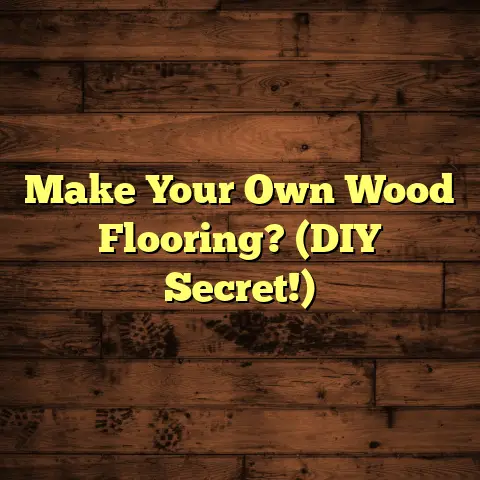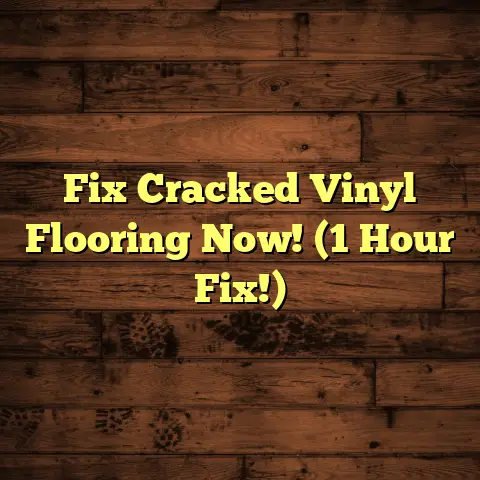Fixing Damage To Hardwood Floors? (3 DIY Blunders!)
I’ve seen it all when it comes to hardwood floors – the good, the bad, and the downright ugly.
And let me tell you, a lot of the “ugly” comes from DIY attempts gone wrong.
We all want to save a buck, but sometimes, trying to fix things ourselves can lead to bigger, more expensive problems down the road.
That’s why I’m here to share my insights on avoiding common DIY blunders when it comes to repairing your hardwood floors.
But first, let’s talk about something important: location, location, location!
Regional Needs and Challenges
Hardwood floors are a classic choice, adding warmth and value to any home.
But what many people don’t realize is that your geographic location plays a HUGE role in how your floors behave and what kind of maintenance they require.
Regional Climate Effects
Think about it: a beautiful oak floor in sunny Arizona is going to face very different challenges than the same floor in humid Florida.
-
High Humidity: In coastal areas like the Southeast, high humidity can wreak havoc on hardwood. The wood absorbs moisture from the air, causing it to expand. This can lead to warping, buckling, and even mold growth. I’ve seen floors literally lift off the subfloor because of excessive moisture!
-
Dry Conditions: On the other hand, in arid regions like the Southwest, the air is constantly sucking moisture out of the wood. This causes the planks to shrink, leading to unsightly gaps between boards and, in extreme cases, cracking.
I remember one client in Nevada who had gaps so wide you could almost lose a coin in them!
-
Temperature Swings: Even regions with moderate humidity can experience significant temperature swings. This constant expansion and contraction can stress the wood, leading to finish cracking and loosening of the nails/glue.
Here’s a quick table to illustrate this:
| Region | Climate | Common Issues |
|---|---|---|
| Pacific Northwest | Damp, Mild | Mold, Warping, Cupping |
| Southwest | Dry, Hot | Gaps, Cracking, Shrinkage |
| Southeast | Humid, Hot | Buckling, Mold, Expansion |
| Midwest | Variable | Gaps, Cracking, Finish Issues |
| Northeast | Cold Winters, Humid Summers | Expansion, Contraction, Mold |
Source: National Oceanic and Atmospheric Administration (NOAA) – Climate Data
(Note: While I can’t directly link to a specific NOAA page here, you can easily find regional climate data on their website.)
Lifestyle and Usage
It’s not just the climate that affects your floors. Your lifestyle plays a big part, too!
-
High Foot Traffic: If you live in a bustling city apartment with lots of foot traffic, your floors are going to wear down much faster than they would in a quiet rural home.
Think about it: all those shoes tracking in dirt and grime act like sandpaper, slowly grinding away at the finish.
-
Pets and Kids: Families with pets and young children face unique challenges. Pet claws can scratch the surface, and dropped toys or spilled drinks can cause dents and water damage.
I’ve had clients who swear their toddlers are secretly training to be demolition experts!
-
Maintenance Habits: Finally, your cleaning habits matter. Using harsh chemicals or abrasive cleaners can strip the finish and damage the wood over time.
I always recommend using a pH-neutral cleaner specifically designed for hardwood floors.
Identifying and Fixing Damage to Hardwood Floors
So, you’ve got hardwood floors. Now what?
The key is to identify damage early and address it before it becomes a major problem.
Common types of damage include:
-
Scratches: These can range from minor surface scuffs to deep gouges.
-
Dents: Often caused by dropped objects or heavy furniture.
-
Water Damage: Can lead to staining, warping, and mold growth.
-
Fading: Caused by prolonged exposure to sunlight.
While many homeowners try to tackle these issues themselves, there are some common DIY blunders that can actually make things worse. Let’s dive in!
Section 1: DIY Blunder #1 – Ignoring Moisture Issues
This is HUGE, folks. I can’t stress this enough: moisture is the enemy of hardwood floors!
Description of the Blunder:
Ignoring moisture levels is like ignoring a slow leak in your roof – it might not seem like a big deal at first, but it will eventually cause major damage.
Detailed Explanation:
-
Assessing Moisture Levels: The first step is to understand the moisture content of your wood. You can do this with a moisture meter, which measures the percentage of moisture in the wood.
I recommend investing in a decent moisture meter; it’s a worthwhile investment.
Ideally, hardwood floors should have a moisture content between 6% and 9%. Anything higher than that, and you’re asking for trouble.
-
Maintaining Humidity: Maintaining proper humidity levels in your home is crucial. Aim for a relative humidity of between 30% and 50%.
You can use a humidifier in the winter to add moisture to the air and a dehumidifier in the summer to remove excess moisture.
I always advise my clients to invest in a good thermostat that displays humidity levels.
-
Signs of Moisture Damage: Be on the lookout for these telltale signs:
-
Cupping: The edges of the planks rise up, creating a concave shape.
-
Crowning: The center of the planks rises up, creating a convex shape.
-
Buckling: The planks lift completely off the subfloor.
-
Staining: Dark spots or discoloration on the wood.
-
Mold/Mildew: A musty odor or visible growth.
-
Fixing the Issue:
Okay, so you’ve identified moisture damage. Now what? Here’s a step-by-step guide:
-
Identify and Eliminate the Source: This is the most important step. Find the source of the moisture and fix it! This could be a leaky pipe, a poorly ventilated crawl space, or even just high humidity levels.
-
Dry Out the Wood: Use fans and dehumidifiers to dry out the affected area. This may take several days or even weeks, depending on the severity of the damage.
I often use industrial-strength fans for faster drying.
-
Stabilize Humidity Levels: Once the wood is dry, maintain proper humidity levels in your home to prevent future problems.
-
Repair or Replace Damaged Planks: If the damage is minor, you may be able to repair the affected planks. However, if the damage is severe, you’ll need to replace them.
Replacing planks can be tricky, so if you’re not comfortable doing it yourself, I recommend calling in a professional.
-
Refinish the Floor: Once the repairs are complete, you may need to refinish the entire floor to ensure a uniform appearance.
Refinishing is a big job, but it can make your floors look brand new!
Section 2: DIY Blunder #2 – Using the Wrong Repair Products
So, you’ve got a scratch or a dent. Easy fix, right? Just grab some wood filler and a stain pen, and you’re good to go!
WRONG!
Description of the Blunder:
Using the wrong repair products can actually make the problem worse.
I’ve seen homeowners use everything from shoe polish to permanent markers to try to fix scratches, with disastrous results.
Detailed Explanation:
-
Incompatible Materials: Not all wood fillers and stain pens are created equal. Some are designed for specific types of wood or finishes. Using the wrong product can result in a mismatched color, a poor bond, or even damage to the existing finish.
I always tell my clients to read the labels carefully and choose products that are specifically designed for their type of floor.
-
Oil-Based vs. Water-Based: Understanding the difference between oil-based and water-based products is crucial. Oil-based finishes tend to have a warmer, richer color, while water-based finishes are more clear and durable.
Mixing oil-based and water-based products can result in a cloudy or uneven finish.
-
Matching Colors: Matching the color of your repair product to the existing floor is essential. Even a slight difference in color can be noticeable and detract from the overall appearance.
I recommend taking a small sample of your floor to the hardware store to ensure a perfect match.
Fixing the Issue:
Okay, so you’ve used the wrong product. Don’t panic! Here’s how to fix it:
-
Remove the Incorrect Product: Use a solvent or stripper to remove the offending product. Be careful not to damage the surrounding finish.
I usually start with a mild solvent and work my way up to a stronger one if necessary.
-
Clean the Area: Thoroughly clean the area with a damp cloth to remove any residue.
-
Select the Right Product: Choose a wood filler or stain pen that is specifically designed for your type of wood and finish.
I always recommend testing the product in an inconspicuous area first to ensure a good match.
-
Apply the Product Correctly: Follow the manufacturer’s instructions carefully. Apply the product in thin, even layers, and allow it to dry completely before applying a topcoat.
Patience is key here. Don’t rush the process!
-
Blend the Repair: Use a fine-grit sandpaper to gently blend the repair with the surrounding finish.
-
Apply a Topcoat: Apply a clear topcoat to protect the repair and blend it seamlessly with the existing finish.
Here are some product recommendations based on my experience:
- For minor scratches: Mohawk Finishing Products Fil-Stik Wood Touch-Up Marker
- For deeper scratches and dents: Famowood Wood Filler
- For general cleaning: Bona Hardwood Floor Cleaner
(Note: I am not affiliated with these brands, but I have found them to be reliable and effective.)
Section 3: DIY Blunder #3 – Neglecting Proper Tools and Techniques
You’ve got the right products, but you’re still not getting the results you want. What’s going on?
Description of the Blunder:
Using the wrong tools or techniques can lead to poor results, even if you’re using the best products.
Detailed Explanation:
-
Sanding Techniques: Sanding is a crucial step in refinishing hardwood floors. Improper sanding can damage the wood, leaving swirl marks, uneven surfaces, or even gouges.
I always recommend using a sanding machine with a dust collection system to minimize mess and ensure a smooth, even finish.
-
Application Techniques: The way you apply finishes and varnishes can also affect the final result. Applying too much product can lead to runs and drips, while applying too little can result in a thin, uneven finish.
I recommend using a high-quality brush or roller and applying the product in thin, even layers.
-
Temperature and Time: Temperature and time also play a role. Applying finishes in extreme temperatures can affect their drying time and adhesion.
I always recommend following the manufacturer’s instructions regarding temperature and drying time.
Fixing the Issue:
So, you’ve made a mistake with your tools or techniques. Here’s how to fix it:
-
Assess the Damage: Carefully assess the damage to determine the best course of action.
If you’ve sanded too much, you may need to replace the affected planks. If you’ve applied too much finish, you may need to strip it off and start over.
-
Correct Your Technique: Practice your technique on a scrap piece of wood before attempting to fix the damage.
Watch videos, read articles, and ask for advice from experienced DIYers.
-
Use the Right Tools: Invest in high-quality tools that are designed for the job.
A good set of tools will make the job easier and produce better results.
-
Take Your Time: Don’t rush the process. Take your time and pay attention to detail.
Rushing can lead to mistakes that are difficult to fix.
Here’s a list of essential tools for hardwood repair:
- Moisture Meter: To measure the moisture content of the wood.
- Sanding Machine: With a dust collection system.
- Hand Sander: For detail work and blending repairs.
- Putty Knife: For applying wood filler.
- Paint Brush/Roller: For applying finishes and varnishes.
- Safety Glasses: To protect your eyes from dust and debris.
- Respirator: To protect your lungs from dust and fumes.
Conclusion: Summary of Key Points
Alright, folks, that’s it! We’ve covered a lot of ground.
Let’s recap the three DIY blunders we discussed:
-
Ignoring Moisture Issues: Moisture is the enemy of hardwood floors. Monitor humidity levels, fix leaks promptly, and dry out any water damage immediately.
-
Using the Wrong Repair Products: Choose products that are specifically designed for your type of wood and finish. Test the product in an inconspicuous area first to ensure a good match.
-
Neglecting Proper Tools and Techniques: Invest in high-quality tools and practice your technique before attempting to repair your floors.
Remember, proper care and attention to detail can help maintain the beauty and longevity of your hardwood floors, ultimately making your home more inviting and valuable.
Don’t be afraid to tackle small repairs yourself, but know your limits. If you’re unsure about something, it’s always best to call in a professional.
Thanks for reading, and happy flooring!





